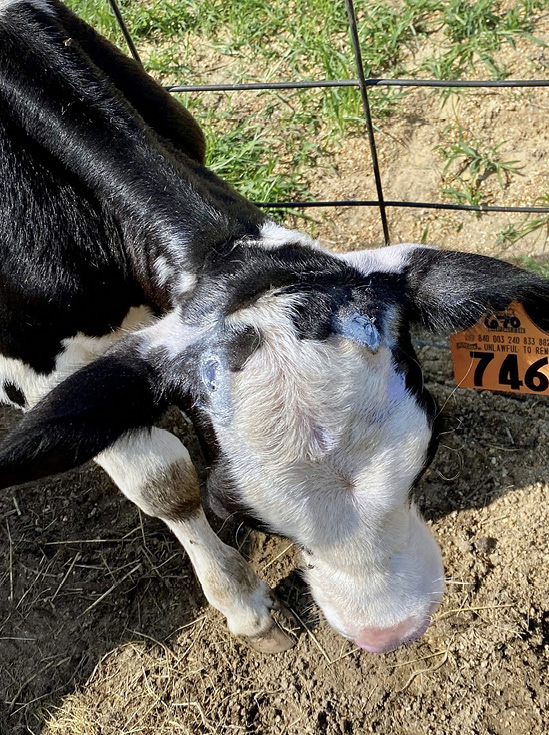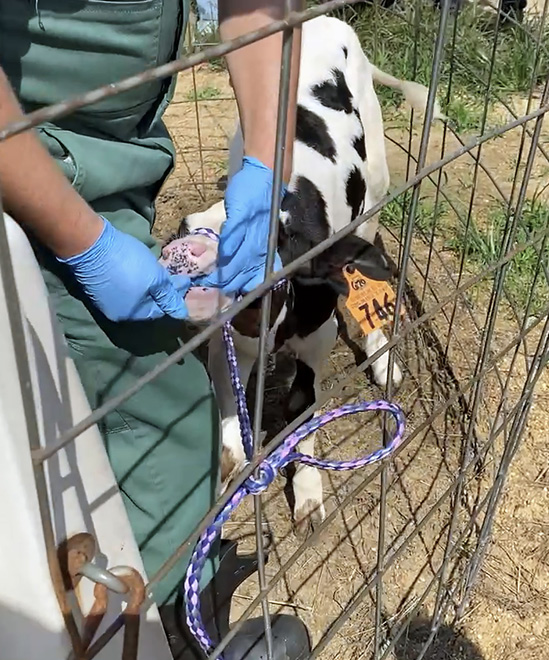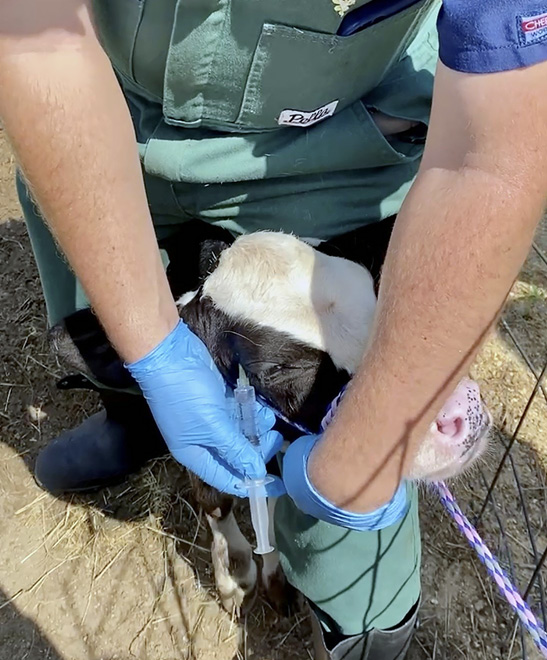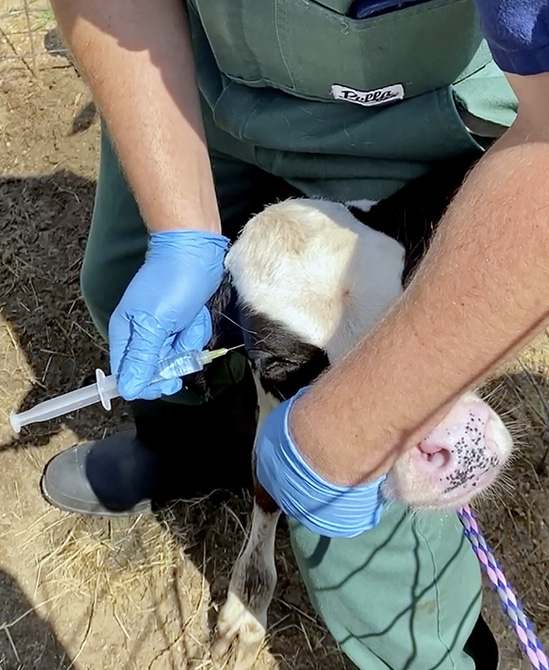Methods for Disbudding Dairy Calves

Figure 1. This is an example of a properly restrained calf for disbudding procedures.
The practice of dehorning or disbudding dairy calves has been implemented on modern dairy farms to prevent injury from horns to caretakers and other animals in the herd. Horn removal also helps prevent problems with horns catching in head locks or chute systems when cattle are being worked. Although often used interchangeably, the terms disbudding and dehorning have different meanings. Disbudding is the destruction of the horn-producing cells of the horn bud, typically in calves less than 8 weeks of age. The horn attaches to the frontal sinus of the skull at about 8 weeks of age. Dehorning takes place after this attachment at 8 weeks or older. Dehorning is more invasive and should be done by a veterinarian, whereas disbudding is a management practice that can be done by dairy producers.
Removing horns when a calf is at a younger age can be less traumatic to the animal because they are not yet attached to the skull. Dehorning at later ages may negatively affect the animal’s performance due to the associated stress and trauma. Methods for disbudding and the process of restraining younger animals are also typically easier compared to older animals and dehorning methods. Because of negative animal welfare and management implications, all calves should be disbudded before 8 weeks of age. Disbudding before 8 weeks may also be required by animal auditing programs like Farmers Assuring Responsible Management (FARM) program version 4.0.
Industry Statistics
According to the 2014 USDA Dairy NAHMS report, 94.3 percent of dairy producers surveyed disbudded or dehorned heifer calves. Here are the four most common methods:
- Hot iron (70 percent)
- Caustic paste (16 percent)
- Saws, wires, or Barnes (16 percent)
- Tube, spoon, or gouge (13 percent)
Note that each producer could choose more than one method. Of these methods, only hot iron and caustic paste met the standard for average age of method application of 8 weeks (done on average at 7 weeks and 2 weeks of age, respectively). When done before 8 weeks of age, scooping can also be used as a method for disbudding. Tube, spoon, or gouge are done at 14 weeks on average, while saws, wires, or Barnes are done at 22 weeks on average. Saws, wires, or Barnes are done when the horn is fully developed, and these methods are not recommended.

Figure 2. This weaned heifer calf has horns that are already fused to its frontal sinus.
Recommended Disbudding Methods
Hot Iron
Using a hot iron is the most common form of disbudding in dairy calves (Figure 3). Hot irons are tools that have a heated element that is applied to the horn bud to destroy the horn-producing cells. Potential benefits of this form of disbudding are that it can be implemented at a young age and does not cause the animal to bleed. Keep in mind no blood does not mean no pain, so appropriate pain management should still be administered. Further, proper training is required to ensure the procedure is being done correctly.
How to Disbud with a Hot Iron
- Ensure the animal is restrained safely and properly.
- Administer pain mitigation.
- Preheat the iron. It should be visibly red when heated properly.
- Place the hot end of burner over the horn of the animal while applying light pressure. Ensure even distribution by twisting or rocking the iron gently.
- Hold the iron on the horn for 10 to 20 seconds. Do not leave the iron on the calf for more than 20 seconds as heat can transfer to the skull.
- Repeat the process on the other horn bud.
- Once procedure is finished, the horn will slough off in 3 to 6 weeks.
Important Considerations for Disbudding with a Hot Iron
- Clipping the hair around the horn beforehand may allow closer contact with the horn bud and ensure a cleaner burn. It will also decrease smoke and inhalation of fumes from burned hair.
- Ensure that the animal’s ears are out of the way of the hot iron.
- The calf may move or jerk its head, so proper restraint is important for safety of the animal and the person performing the procedure.



Figure 3. Apply pressure with the hot iron (top photo) for 10 to 20 seconds. To ensure horn growth will not occur, check the color of the germinal tissue where the horn bud is. A copper-looking color signifies destroyed germinal tissue (bottom photo). To limit infection, spray aluminum-based bandage on the horn bud site and spray around the area with fly spray (not directly on the horn bud).
Caustic Paste
The second most common method of disbudding dairy calves is caustic paste. Advantages of this form of disbudding are that it can be done at an early age, does not cause the animal to bleed, and can be less stressful than using a hot iron (in other words, less restraint, noise, and smell). Caustic paste is a strong irritant, so it is crucial to ensure it does not get on the handler’s skin or improper areas of the calf. When the paste is not administered correctly, horns or scurs can grow, and the producer may have to pay a veterinarian for a second procedure to remove the horns when the calf is older.
How to Disbud with Caustic Paste
- Ensure the animal’s head is properly restrained.
- Administer pain mitigation.
- Clip hair around the horn bud.
- Put on gloves.
- Apply a thin layer of caustic paste with a wooden applicator to the horn bud.
- Place a layer of duct tape over the paste to prevent rub off or leakage into the calf’s eyes.
Important Considerations for Disbudding with Caustic Paste
- Clipping the hair around the horn bud is not recommended, as the hair can cover the paste after application and help to protect the calf.
- Once paste is applied, covering the horn can help seal it into the correct area. This step can be done by using duct tape to cover the area where paste was administered.
- Housing calves individually for a short time while paste is still wet can help decrease the chance of paste transferring from calf to calf.
Dehorning Spoon or Tube
Removing horns with a spoon or tube is one of the least popular forms of disbudding according to the USDA. Also known as scooping, this method is done by using a sharp metal dehorning scoop, spoon, or tube to cut through the horn-producing skin and the horn bud. Advantages of this method are that it is quick and efficient and can be done in young calves. Disadvantages are that it requires a trained and experienced handler and creates an open wound that could attract flies and become infected.
How to Disbud with a Spoon or Tube
- Ensure the head of the animal is properly restrained.
- Administer pain mitigation.
- Place the sharp edge of the tool around the horn.
- Apply hard pressure to the tool while also twisting to ensure that all tissue is cut through.
- Use a scooping motion to get through all tissue.
- Apply antiseptic to the wound to help prevent infection.
- Check the wound and apply antiseptic daily until healed.
Important Considerations for Disbudding Using the Scooping Method
- There are different sizes of spoons and tube tools available. The proper size depends on the size of the animal being disbudded. The tool should cover the entire horn bud with an additional 1/8 inch of skin surrounding the horn bud.
- Animals will jerk their heads, so proper restraint is required.
- Always clean tools with water and a disinfectant like chlorhexidine between animals to decrease chance of passing illnesses and infections.
- Because this method creates an open wound, scooping during fly season is not recommended, as flies can increase infection risk.
Pain Mitigation
The only painless way to have hornless cattle is to select for genetically polled animals. The USDA reported in 2013 that 25 percent of dairy operations in the United States were utilizing semen from polled bulls. However, this may not be the best option for some producers, and it does take generations to fully achieve a polled herd. Therefore, it is important to follow practices to remove horns with the least amount of stress to the animal. Although disbudding may be less painful than dehorning, it is still painful, and pain mitigation is recommended for both procedures. Pain mitigation can include nonsteroidal anti-inflammatory drugs (NSAIDs), local anesthetics, or a combination of pain-reducing and pain-relieving drugs.
Not using pain relief when disbudding or dehorning compromises the comfort and welfare of the calf. Of the 94 percent of dairy producers who removed horns from their heifers in the NAHMS survey, only 28 percent used analgesics or anesthetics. Anesthetics are used to mitigate pain. They cause loss of physical sensation and possibly loss of consciousness. Analgesics provide pain relief without loss of physical sensation or consciousness. Of the 70 percent who used a hot iron to disbud, 30 percent used pain relief. Of the 16 percent of producers who used caustic paste, only 6 percent provided pain relief. Although any person is permitted to administer pain mitigation, veterinarians were most likely to use pain relief during the process of removing horns, and owners were least likely (63 percent of veterinarians and 15 percent of producers). Therefore, there is room for improvement of pain mitigation, particularly for producers performing horn removal themselves.
Pain mitigation should be administered to the animal between 5 and 20 minutes before the procedure. Producers have several pain-mitigation options, but the most commonly used are short-acting local anesthetics like lidocaine (Saraceni et al. 2021). Local anesthetics will typically relieve pain for up to 2 hours. However, combining local anesthetics with NSAIDs like ketoprofen or meloxicam can help extend the pain relief for the calf even after disbudding is done. To deter reactive behaviors in calves during disbudding—such as head tossing and falling—sedatives can be used. Sedatives are not effective for pain management, so they should not be used alone. They can provide a safer environment for both calf and human. The proposed best method for pain relief for calves is to administer a combination of a sedative, local anesthetic, and postprocedure NSAIDs to provide the best opportunity for pain mitigation.




Figure 4. There are two ways to properly administer pain medication. Oral medications can be given to the calf by coaxing it to suckle your fingers while you hold the pills. This will cause the pills to enter the stomach of the calf (top photo). Injectable pain mitigation is shown in the two middle photos. While letting the pain mitigation settle and take effect, shave the horn area of the animal to expose the buds (bottom photo).
Conclusions
Disbudding before 8 weeks of age is recommended and allows for a less stressful experience for the animal and handler. Although all forms of disbudding are painful, there are means for limiting the amount of pain the calf experiences. Therefore, proper pain mitigation strategies are important to a successful disbudding program. To ensure proper pain mitigation, consult your veterinarian and establish a disbudding program together to optimize management for your farm. To avoid the risk of missing animals and having to remove horns at a later age, proper training is needed to make sure disbudding is being done properly the first time. It is also important to keep proper records. Finally, for all disbudding procedures, the safety of the animal and the human handler should be the number-one priority.
References
Castration and dehorning of cattle. Accessed March 6, 2022. https://www.avma.org/resources-tools/avma-policies/castration-and-dehorning-cattle.
Dehorning of Calves. Accessed March 6, 2022. http://www.omafra.gov.on.ca/english/livestock/dairy/facts/09-003.htm#hot.
Disbudding and Pain Management for FARM v4.0. 2020. Accessed March 6, 2022. https://www.vet.cornell.edu/animal-health-diagnostic-center/programs/nyschap/modules-documents/disbuddingpainmanagement.
FARM Animal Care Version 4. Accessed March 6, 2022. https://nationaldairyfarm.com/farm-animal-care-version-4-0/.
Inc, H.W.N.C. Dehorning Methods. Accessed March 6, 2022. http://www.dehorning.com/dehorning-methods.
Saraceni, J., C. B. Winder, D. L. Renaud, C. Miltenburg, E. Nelson, and J. M. C. Van Os. 2021. Disbudding and dehorning practices for preweaned dairy calves by farmers in Wisconsin, USA. Journal of Dairy Science 104:11995–12008. doi:10.3168/jds.2021-20411.
Stafford, K. J., and D. J. Mellor. 2005. Dehorning and Disbudding Distress and Its Alleviation in Calves. Veterinary Journal (London, England: 1997) 169 (3): 337–349. doi:10.1016/j.tvjl.2004.02.005.
Stuttgen, S., and J. V. OS. Disbudding Calves. Accessed March 6, 2022. https://livestock.extension.wisc.edu/articles/disbudding-calves/.
USDA NAHMS Dairy 2014: Dairy Cattle Management Practices in the United States, 2014.
Welfare Implications of Dehorning and Disbudding Cattle. Accessed March 6, 2022. https://www.avma.org/resources-tools/literature-reviews/welfare-implications-dehorning-and-disbudding-cattle.
When and How to Disbud Dairy Calves | Animal and Food Sciences. Accessed March 6, 2022. http://afs.ca.uky.edu/content/dairy-when-and-how-disbud-dairy-calves.
The information given here is for educational purposes only. References to commercial products, trade names, or suppliers are made with the understanding that no endorsement is implied and that no discrimination against other products or suppliers is intended.
Publication 3835 (POD-11-22)
By Kevin Braman, Graduate Research Assistant, and Amanda Stone, PhD, Associate Professor, Animal and Dairy Sciences. Dr. Michael Pesato, DVM, allowed the authors to photograph the processes shown in Figures 3 and 4.
The Mississippi State University Extension Service is working to ensure all web content is accessible to all users. If you need assistance accessing any of our content, please email the webteam or call 662-325-2262.





